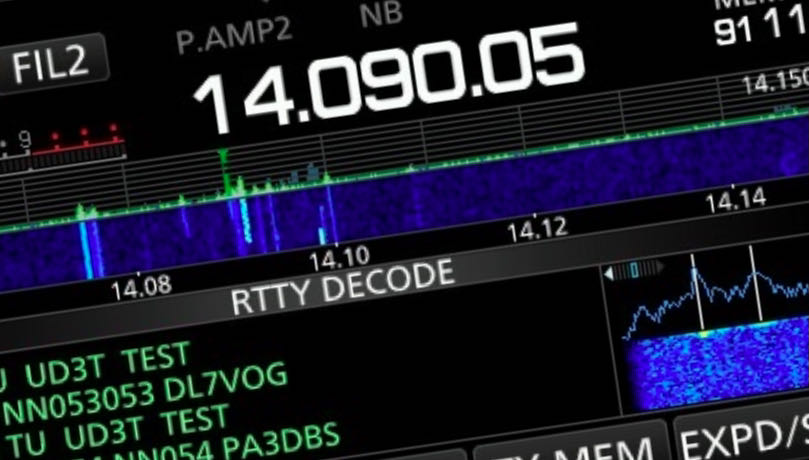 Many thanks to SWLing Post contributor, 13dka, who shares the following guest post:
Many thanks to SWLing Post contributor, 13dka, who shares the following guest post:
The Icom IC-705: Is this really a new holy grail SWL/BCL receiver?
by 13dka
When Thomas got wind of its development in 2019 he immediately asked “could the Icom IC-705 be a shortwave listeners holy grail receiver?”. I usually wince a little when I hear “holy grail” because it means very different things to different people, it’s also a moving target with many people aiming at the spot where it was decades ago. But Thomas certainly had a very level-headed assembly of technical performance, quality and practicality requirements in mind when he used that term, and I thought he might be onto something!
There are some excellent, trustworthy reviews of the IC-705 out there. The following is not one of them, I just want to share an opinionated breakdown on why I think this is an interesting radio for SWLs/BCLs indeed, also deliberately ignoring that it’s actually a transceiver.
Jumping shop
While the era of superhet/DSP-supported tabletop holy grails ended with the discontinuation and sell-off of the last survivors more than a decade ago, powerful PC-based SDR black boxes were taking over the mid-range segment and it became very slim pickings for standalone SWL receivers: Thomas just recently summed up the remaining options here.
Between the steady supply of inexpensive yet serviceable Chinese portables, upgraded with a least-cost version of DSP technology, and the remnants of the high end sector there’s very little left to put on the wish list for Santa – that doesn’t need to be paired with a computer that is.
No surprise that SWLs/BCLs in search of new quality toys with tangible controls are taking a squint over the fence to the ham transceiver market: Hams are still being served the best and the latest in radio technology in all shapes and sizes, and even entry-level rigs usually come with feature-rich general coverage receivers. But transceivers never had SWLs much in their focus in the past decades, and particularly not BCLs: Frontend adaptation, additional AM filters, switches and functions would’ve meant increasing costs and so transceivers were never perfected for that purpose. DSP and SDR technology allowed for improvements on that without actually adding (much) hardware and so some interesting alternatives surfaced in the past years, but most of them still come with little downers, at least for BCLs.
Also, it was always quite a leap to pay substantial money for radios that usually lack something concerning SWL/BCL usage somewhere, be it sensitivity on MW, filter options or functions not available in all modes, and then having (legal, safety, money) worries about a transmitter lying dormant in that radio, particularly for people who have absolutely no plans on getting a license. I wasn’t considering any of those for yet another reason:
I just want it all…to go!
Being interested in all things radio, shortwave and beyond and forced to be a “DX nomad”, I always wanted to have top-notch wideband SDR performance at my remote listening posts on the German North Sea coast, to fully harvest the rich DX fishing grounds they offer on the entire radio spectrum.
I took my SDR boxes to the dike a few times but that turned out to be rather frustrating: In that noise-devoid environment, a lot of separation between the laptop in the car and the antenna is needed to avoid picking up residue digital hash from the laptop, then my laptops turned out to run out of juice within ~2 hours because SDR software is taxing the CPU and I couldn’t find a car charger that didn’t emit catastrophic QRM levels. Last but not least putting up all that stuff was a lot of hassle for just 2 hours of fun. So I was waiting for a battery-powered, standalone, wideband SDR with all of the performance advantages and features SDR technology brings, one portable radio to cover everything. The ham market had nothing like this to offer, and I sure didn’t expect it would come from Icom to challenge holy grails. Speaking of which:
A true new holy grail must be a step up from the last one, and it took a while until SDRs could achieve that in all aspects. I always considered the Icom IC-R 8600 to be that radio, it caters for everything an SWL/BCL would want, but it has one major flaw in my book: Considering the ever-deteriorating noise situation and ever-increasing hardships to put up reasonable antennas spoiling the fun for so many of us at home, I feel that a new holy grail radio is not only supposed to have outstanding performance and features, it should be as portable and practical as possible to make it easy to use them at off-grid places, where that performance can still be utilized to its full extent!
The egg-laying wool-milk pig
Cue the IC-705 – its coverage is 30 kHz-200 MHz without gaps, then 400-470 MHz on top, it has everything the SWL and BCL in me wants in a top-notch all-purpose receiver and also covers most of my “points of interest” beyond shortwave – all mode VHF/UHF ham bands, all FM broadcast bands, airband(s), I can hunt LEO satellites, ship traffic on VHF or radiosondes on 400 MHz…
It’s powered by a somewhat ubiquitous Icom snap-in battery format, it has a big comfy VFO knob, some rotary encoders and buttons on the front panel for good haptics and of course a friendly color touchscreen to manage the SDR-typical flood of functions. When Thomas reported that the receive-only endurance would be satisfying 7 hours with the included BP-272 battery I knew this is (well, lets say 90% of) the bag of tricks I was waiting for! But let’s take a look at how holy-grail-good it really is:

Left image: Radiosonde (weather balloon) on 400 MHz. Tracking them and trying to locate the debris is a cool “radio sport”! Right image: Daytime cheat for wishing on shooting stars: Small meteor in range of the French GRAVES space surveillance radar.
The nitty gritty radio stuff: Sensitivity, selectivity, dynamic range and all that jazz
Sensitivity
Let’s start with how quiet this radio is: The 705’s noise floor is on par (within a few dB) with the very best of current ham transceivers and no hissy audio amp is spoiling that at the other end. Likewise, the sensitivity figures are matching those of other transceivers, with the differences being on the second decimal place: 0.16 microvolts on SSB is not breaking any records but it’s still an excellent result.
The preamp has two gain settings (‘P.amp 1’ =13dB and ‘P.amp 2′ =18dB) below 30 MHz, with the second being quite suitable for antennas with very low output: It works great with small passive loops like the YouLoop and other lossy antenna types. I even tried the radio successfully with a mere 1m/3’ telescopic whip connected directly to the radio at home and also mounted on a tiny and pretty awful magmount on the car roof at my dike listening post. To my surprise it didn’t leave much to desire in terms of reception with this absolute minimum of an antenna, even on long wave – it just felt like a regular portable, with lower S-meter readings but better signal quality compared to my regular portables.
Video: The IC-705 and the S-8800 on my window sill wearing nothing but whips!
Sensitivity is rarely an issue with modern radios anyway, with one exception: Many ham transceivers with general coverage tend to reduce sensitivity on medium wave to relieve the frontend on 160m. The 705 doesn’t seem to do that (much)! Confusingly, Icom’s spec sheet table claims the opposite and lists the AM sensitivity below 1.6 MHz much lower than it actually is, it looks as if they use the same table for a lot of their radios. Real world sensitivity measurements as done by AB4OJ [PDF] prove the opposite and confirm my personal impressions: below 1600 kHz the signal drops by a smidge (maybe 3-5dB), that’s all. I used the 705 all over the winter for my first successful transatlantic MW DX season.
It leaves the same excellent impressions on FM and above, just using the BNC whip it picks up my benchmark FM stations just as well as any of my SiLabs-powered portables, which Jay Allen rates as the most sensitive ones you can get for FM. It even could have been a proper FM DX radio if it wouldn’t have just a fixed 200 kHz WFM filter: The IC-705 doesn’t do stereo or RD(B)S so it could’ve gotten away with a much narrower filter implementation (variable or not) for WFM, but of course this would’ve been far beyond the typical scope of such a radio. It does proper AM airband reception with variable filter and proper 8.33 kHz steps though and it’s outclassing my (otherwise brilliant) AirSpy HF+ Discovery in that role. The general VHF/UHF goodness can be felt all the way up to 470 MHz.
Video: Checking in on the grampa of lower earth orbit: “Zombie satellite” NNSS O-2 (aka “Transit 5B-5”) passing by in the distance, still trying to transmit telemetry after 56 years! (Received at home with the YouLoop indoors.)
Dynamic range:
The IC-705 was tested by Rob Sherwood and the results listed on his great receiver list, which has data of ~150 radios to compare it with. That list is sorted by “narrow spaced dynamic range”, which describes the ability of a radio to cope with strong signals in the same passband only 2kHz away. Now this is only one very specific property of a radio (a worst-case scenario e.g. in contesting) so the exact position in that list has little meaning beyond that one thing and Rob keeps stressing on this, yet it’s frequently misunderstood as a kind of universal ranking list. What’s interesting in this context is that there’s only one other self-contained, portable TRX besting the IC-705 in terms of general and “narrow spaced” dynamic range and even sensitivity – the Elecraft KX3 (with the optional roofing filter).
A more important (to me) metric is the “Blocking Dynamic Range” (BDR). This may not be as much of an issue for many of you fellow US listeners but it sure is here in central Europe since there are still plenty of high-power shortwave broadcasters in first-hop distance: BDR describes the resilience against hot signals outside of the IF passband (in this case 100 kHz away). Ignoring the technical difference between BDR in legacy radios and the ADC clipping point in direct sampling SDRs, the 122dB for the IC-705 is >20 dB less than what current high-end transceivers (or some boat anchors with preselectors) can achieve, but still better or at least on par with most upscale SWL tabletops of the pre-SDR era, in the ballpark of the IC-R8600 and even a meaningless smidge better than the mighty IC-R9500.
That being said – the incredible blowtorch signals from e.g. RRI, CRI or Vo Turkey, often peaking at 9+60 on their evening 49/41/31m transmissions really probe the dynamic range of a radio, not only at the dike. Remember, the ocean location alone boosts signals by 10 dB, so my new makeshift fiberglass pole 1/4 lambda vertical for ~7 MHz can have some respectable output there. The practical test here is not if it overloads, but when and how severe the radio responds to it and how much sensitivity I have to give up then. I’m glad I can say it did very well: 99% of the time it was just at the brink of clipping (with the preamp on!) and actual “overflow” can be managed with fine granularity just using the RF Gain control on this kind of radio, preserving weak signal reception capability and avoiding needlessly severe sensitivity losses. If you set up camp in the shadow of a transmitter site, there’s also a built-in 20dB attenuator.
Video: Driving the IC-705 to its limits, minor artifacts can be noticed in the second minute. ]
Selectivity
A wide selection of filters is pretty rare on legacy radios of all kinds, much less continuously variable bandwidth, allowing me to find the best compromise between sound quality and interference rejection.
IF selectivity on the 705 is provided by an SDR-typical variable (bandwidth, shape) filter followed by the somewhat idiosyncratic, Icom-typical “twin passband tuning” configuration for quick management of difficult DX station neighborhoods. Unlike many competitors for the imaginary “recommendable ham transceiver for SWLs” placard it pleases BCLs with up to 10 kHz IF bandwidth in AM, CW fans and NDB DXers can go as narrow as 50Hz to squeeze maximum SNR out of weak stations, and RTTY afficionados enjoy a dedicated RTTY mode with an additional twin peak (audio) filter option. Each mode has its own set of 3 configurable filter presets except NFM, which has 3 different fixed bandwidth filter options.
The only thing preventing full perfection is the maximum bandwidth being 3.6kHz in SSB, so zero-beating AM stations still comes with a little bit of a compromise re treble frequencies. But the SSB filter comes with a “soft” shape acting like a classic analog filter and a “sharp” setting with much less rounded shoulders, passing noticeably more bass and treble and making music programs quite enjoyable for me, even in SSB.
Other reception tools
– You can choose between an IF auto notch filter to get rid of simple hets and a highly efficient and configurable manual notch filter, which is sitting in the AGC loop and offering 90dB of rejection to keep severe cases of interference from messing with the AGC action. Some older, 90s/2000s era ham TRX have DSP functions like this “tacked on” (sometimes optional) in the audio path only, which is not the place where they can do their best.
Video: Using the manual notch filter to kill a RTTY signal interfering with Radio Rebelde
– The AGC has adjustable (decay time only) fast, medium and slow presets…of course per mode again! Each of the 3 presets can also be set to be an “OFF” position. I don’t want to live without the extra slow (up to 6s) setting on local SSB ragchewing channels, keeping the radio very quiet when they pass on the mike.
– It has an excellent (!) variable IF-level noise blanker that feels like a godsend with the various pulsating QRM sources in my home, and of course noise reduction if need be. I admit being not particularly fond of digital noise reduction algorithms in general, they often create some odd, warbling sound and on the IC-705 even mild settings drop the volume a bit. It does its job and I found it a bit more likable on broadcast stations but on higher settings (>3) the “adaptive” part of the algorithm becomes increasingly obvious, the phasing sound caused by selective fading gets emphasized much, and a weird reverb effect can often be heard, reminding me that there is room for improvement.
– On the audio side of the IC-705 you can shape the signal with bass and treble tone controls or alternatively pairs of variable audio LP/HP filters, each again with separate settings for each mode. Speaking of sound, the built-in speaker is providing a very pleasant “communications receiver” sound but the small speaker doesn’t allow for more than that of course. Due to the internal tone controls, all you need to harvest its full broadcast sound potential is a big old passive station speaker or a good pair of cans. I can’t emphasize enough how much a good speaker can unveil the true qualities (or the lack thereof) of a radio and how massively it can increase the fun you have with it!
To summarize this so far – the IC-705 may not be the #1 in any of the raw performance metrics but everything is so uniformly close to the very best performers on the market that the net result is an impressive receiver playing solidly in the top tier of current transceivers. The performance is also scarily close to the IC-R 8600 and IC-R 9500, so it has the same power to send most of the former holy grails (according to the Sherwood list) into retirement. I’d sure prefer to do my own practical comparisons with all those radios instead of merely referring to that list, on the other hand I have no reason to doubt Rob’s measurements, not only because my experiences with the 705 are so positive.
What, no sync detector?
Besides ham TRX never coming with sync detectors, I feel this recurring bone of contention is subject to some misconceptions, so to put that a bit into perspective:
Why do we want a sync detector in first place? (1.) We want to stabilize the signal and mitigate the nasty distortion caused by “selective fading” (when the wandering notches in the spectrum pass through the carrier and attenuate it) and (2.) if need be, we also want to select the sideband with the least amount of interference.
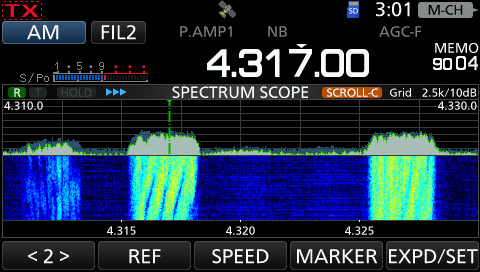
“Selective fading” made visible on a STANAG station: Small time-of-arrival differences creating a comb-filter effect, with the notches drifting slowly through the signal.
Sync detectors were invented to make superimposing an internally generated carrier to achieve (1.) a consumer-friendly “flick of a switch” deal, at the same time reducing the technical demands on oscillator stability and precision. Long story short: By the time this technology became ready for the mass-market, FM came up, the interest in AM radio waned and amateurs turned to SSB, so sync detectors made it into our “special interest” receivers only.
But they often leave a lot to desire: Once they lose the lock to the original carrier they start wandering off with a loud howl, in some cases they have difficulties re-establishing the lock again and generally only few radios had fully convincing sync circuits so far. Zero-beating AM stations in SSB was and still is the alternative: There is no “magic” making sync detectors inherently “superior” beyond automatically aligning the carriers. Now even many inexpensive radios have sufficient stability and don’t need constant retuning to “zero”, but they often lack the precision and need different settings on each band, many allow only for a coarse approximation to zero-beat due to 10Hz tuning steps.
On the other hand, radios like the IC-705 have very stable (<0.5ppm) oscillators, usually painstakingly aligned to a frequency normal before they leave the factory. They allow you to simply switch to SSB and be done with it – as long as the station is well-maintained no additional alignment is needed, otherwise you can long-tap the decimal places on the 705’s display to switch to the 1Hz tuning mode and zero-beat the station precisely. The signal improves and the carrier-loss distortion disappears just like with a sync detector and there’s no lock to lose, so I prefer this arrangement over a wonky sync detector anytime. What’s missing is a way to use both sidebands and the wide AM filter but then again, even the sync detector on the JRC receiver that probably coined the “ECSS” acronym (that’s now often used wrongly to describe “zero-beating”) lacks this capability. Of course point (2.) is automatically covered by zero-beating the station in SSB to achieve (1.) but it’s also a pretty moot point on a radio that has passband tuning and notch filters: Any interference on one sideband can be addressed with these tools way more “surgically” than with a sync detector, while simply staying in AM mode.
Audio: Demonstration of carrier-loss distortion and recovery through zero-beating (Absolute Radio, 1215kHz)
Toys R Icom
Besides almost mundane frequency management features like dual VFO, 500 alphanumeric memories, a fast-access “memory pad” for up to 10 favorite frequencies and 3 “band stacking registers” per band (for a quick jump to recently worked frequencies including mode and filter settings), the 705 brings some quite extraordinary gadgets to play with: It has Bluetooth for BT headphone/headset owners or a nice big BT speaker and – which is a first – WLAN for wireless (= XYL-approvable) connection for full (including spectrum and waterfall!) remote control via your home router from a computer, on your front porch or anywhere on the world via the internet! Icom provides the RS-BA1V2 remote software (Windows only), which costs $149 in the US and 80€ (=$97) in Germany. But there is also an open source alternative available for Windows, MacOS and Linux called “wfview” working with all network-capable Icoms – for free.
It also has a built-in GPS receiver so it knows where it is (and what repeaters are around you), which is mostly important for D-STAR but it also lets you record GPS tracks and syncs the internal clock to the GPS atomic clocks…and apparently it can be used as a super-precise time server for other devices when you’re out of internet coverage (important for modes like FT8). It can internally decode (and encode/transmit of course) RTTY, log transmissions, make screenshots and the US version has a dedicated WX band.
At this place I would’ve loved talking about how cool D-STAR is – if I had ever picked up someone using it. Among 4-5 DMR etc. repeaters in range there is one D-STAR-repeater 80km/50mi away and I can hear it – it identifies itself and tells me the time once per hour but that’s all activity there ever is – hams are clearly preferring the other side of the “big digital voice divide” over here. The most important “toy” of course is the highly configurable spectrum and waterfall display. This is one of those features some people see and think “yeah, nice but I don’t really need that” or even dismiss it as “bling”…until they really tried it hands-on and eyes-on for a while!

Same radio (duh!), same settings, same antenna (YouLoop), same orientation (E-W) but different location (left = at the dike, right = at home, with the YouLoop even mounted outside): Spectrum and waterfall making the benefits of going out of town immediately obvious.
BC Dxers can easily spot e.g. carriers coming up from across the oceans on MW (long before actual reception is possible!) or assess the conditions on entire SW bands at one glance, SWLs and utility DXers enjoy the fact that no activity on a band could go unnoticed while they’re watching the waterfall and you can quickly jump to that activity by tapping the screen at that spot. It makes you find weak signals you would’ve missed without the display and once you’ve gained some experience with it, it subtly provides a whole lot more immediate information about band conditions, signal quality, modulation type or noise level, QRM sources, SNR…too much to describe in detail here.
And of course it’s also “bling”: The display can be set to “Fixed” mode, then the little marker line that’s usually at the center of the spectrum moves across it instead – like on an old-school radio’s slide rule dial…on steroids, showing actual activity to tune in on the waterfall below. The maximum visible chunk of the spectrum is 1MHz, which is more than enough for the 4.5″ screen on the narrow-channeled shortwave bands and just enough on the FM BC band. If you still don’t want that – just turn it off to make way for an audio scope, a lush metering cluster, memory/VFO controls or just the chunky version of frequency readout and S-meter.
If need be, a nice YL will read both to you by pressing a dedicated button near the VFO knob, right next to the knob that auto-tunes CW signals to the filter center…if it would make coffee or fill out my tax forms on top of all that, I’d probably marry it and take its name! Ollie 705! But there’s more:
Memories and scanning
Most transceivers have 100 memories (give or take a few) in a lackluster, “flat” list. Probably owed to VHF/UHF and digital voice, the IC-705 takes that a bit further and offers 500 memory channels that can be organized in “groups” (= folders or banks), which is much more apt for SWLs interested in all the facets of the hobby. What’s making this great is that both memories and groups can be named, displayed and managed conveniently via the touch screen. The channels in a selected group can be browsed with the [MULTI] encoder, which is also a convenient way to teach the 705 what “broadcast bands” are – enter all starting frequencies of all broadcast bands in a group, then the [MULTI] knob can be your band switch.
If 500 memories don’t cut if for you – the size of your SD card is the limit! The 705 can export/import all or parts (for example only the memories) of its settings to the SD card so you can have multiple settings files and memory sets for different purposes! For example, I saved a lot of HF aero frequencies to a memory group and sorted them initially by location/purpose (Atlantic tracks, Pacific tracks, LDOC…) but then I thought it would be better to sort them by frequency – after saving that version I can choose between both variants. Icom provides a free “CS-705” configuration software download to manage all settings, it also gives you a way to enter and manage memories even more comfortably, but the radio has all the needed tools to do that w/o a computer.
“Look ma, no hands!” The IC-705 slowly turning the big knob for me, a whole new dimension of laziness!
The 705 is not really a scanner, and scanning a large frequency range in VFO mode like e.g. the air band is not particularly fast (depending on step size, I made that deliberately slow in the video), but for being not-a-scanner it has a lot of modes for scanning (user-definable) ranges anyway. Memory scan is considerably faster and it also has lots of ways to scan the memories – you can just scan the whole memory group (for example, I have all VHF marine radio channels in a group so it scans them all pretty quickly) or you can pick individual memories from all of your groups for 3 different “selection groups” in order to scan those selected channels only. If you want to skip a channel, just mark it via a function in the [QUICK] menu. Looks like the IC-705 inherited some DNA of the IC-R30 handheld scanner as well.
Recording
It hurts how many great radio moments at the dike I failed to preserve for posterity because I forgot to bring my cellphone or couldn’t get it out fast enough! With the 705’s built-in recorder, capturing those is only 2 buttons away (“Quick”-button -> tap “Start Recording”) and I don’t have to think about media capacity etc. – the Icom accepts MicroSDHC cards up to 32GB and that will give you a recording time of ~550 hours, that’s more than 3 weeks of recording 24/7! If you can’t stay glued to the radio for some reason (phone call, taking a leak), just hit record and scan the file for the station ID later!
Alas the 705 doesn’t do baseband (“spectrum”) recording or “timer recording” but it can automatically (squelch-triggered) record activity in a single file or in separate files per activity and it tags them with time, frequency and mode. Together with the cool scan features that can be used to log activity on selected channels, whole groups or even bands, automatically and unattended: Let it scan, leave the house, when you’re back you can check the “Record” menu for what it picked up at what time on what frequency and quickly browse through the recordings it made.
There are also two little shortcomings: The file format is uncompressed 16-bit mono .WAV at a reduced sample rate of 8kHz to keep the file sizes in check. That means the recordings are easily readable in any editor software you like but they’re also limited to 4kHz of audio bandwidth, which is fine for most modes but will cap the top end of wide-filter AM or FM recordings. The other one is that you can’t access your recordings and screenshots directly via the USB – you have to take the SD card out and put it in a card reader (or some other device with SD card access via USB, like some audio recorders) in order to proudly post your recordings here on the SWLing Post.
Mission control center: Firmware and ergonomics
I was not familiar with the new Icom “platform” and the concept common to all new (-ish) Icom radios, so “just like the 7300” meant little to me. I appreciate that this is a highly subjective matter but once I understood how this radio rolls, I found it very intuitive and surprisingly fast to access functions. You just need to keep 2 things in mind: 1.) Many switches and menus are “context sensitive”, for example the [MULTI] knob’s push function opens different options depending on what mode (SSB, CW, FM) you have set, the “Scan” button has different options in VFO vs. memory mode etc. and 2.) physical and virtual buttons and even many menu options can be pressed shortly to do one thing and longer than a second to do something different. That way nothing essential is buried in a deep menu structure and more things can be done without touching the screen much.
There is often more than one way to access some option, to use a function or to jump to a different band, and you can move the furniture around a bit to your liking. Every once in a while I sat there scratching my head but after checking the manual I asked myself why I didn’t think of that in first place! Unlike radios that just pour options into flat, uniform menu structures in lieu of an actual concept, I find the Icom’s operation thought out very, very well, with consistency and practical use in mind.
Some examples: Navigating through your recordings with the on-screen buttons is nice but selecting files and folders with the rotary knob (turn to select, push to enter folder/play file) and the VFO knob acting as a “jog wheel” to move the playhead through the file is much faster. Another one: After 5 months I found out that you can do a long push on any parameter in the right-hand pop out menu (when you push the [MULTI] knob) and then you can have variables like manual notch frequency, noise reduction level (or mic gain, keyer speed (!)…) permanently assigned to that knob until you long-tap that parameter again.
I guess the firmware codebase behind all this has a pretty long history in Icom’s SDR-based radios, it was already mature and solid in its first version on my early 705. The recent 1.20 upgrade was only released to add new and improve existing features, and most of that upgrade was quite beneficial for SWLs! For example, the latest additions improve the “fixed” waterfall mode or let you assign notch filter/NB/preamp/etc. switching to a front panel button.
Connecting a computer
Another superb property of the family is that the Icoms don’t require any additional audio cables or physical com ports to use it with digimode/decoder software! Once connected to the computer via USB cable, the 705 appears to the OS as an additional (“class compliant” – no driver) sound card and it comes with a USB driver providing a virtual com port for CI-V control. All you have to do is loading your WSJT-X, FLDigi, whatever you like software and select the 705’s internal USB sound device for input/output and com parameters for control. That’s a tidy way of connecting a computer and saves you setting up virtual audio cable etc. to pipe soundcard ins and outs to the software, like it’s customary with regular SDR boxes. That also means your computer’s regular audio device and speakers remain available for music, video or whatever you may want to do on the side.
Even better – since the last firmware upgrade, all required in/output configuration settings can be saved as presets in the 705, so you can conveniently switch between multiple configurations within seconds! But you can also forget what I just wrote, all this isn’t even necessary for SWLs and simple decoding – there is no urgent need to setup CI-V, the USB audio output is already set right by default and generally runs independently from the regular speaker output, so you can just connect the computer, start your decoder software, select the Icom’s audio device for input once and you’re good to go. You can also simply (without changing any settings) connect your smartphone via OTG cable to pipe audio into (e.g. CW-decoding) apps that would otherwise use the phone’s mic! Regular SWLing Post reader “Mangosman” might like that Icom made sure the audio device can be set to send a 12 kHz I/Q-signal over the USB in order to decode DRM streams. 🙂
Versatile power options
Despite the overwhelming feature list, the 705 has relatively moderate power requirements when used receive-only. By turning off functions currently not needed, the current draw can be reduced to ~175mA (from 330mA) on the 12V terminal and to 530mA (from 900mA) on the USB port. Being that efficient also means it doesn’t try to heat up the prairie, particularly when used as a receiver.
You can run the radio off the internal battery, a 12V external power source and via the USB port, that’s plenty of options to charge the battery and run the radio without:
– A small (quality, low-noise 2+ Amperes quick charging) phone charger lets me charge the battery or run the radio (receive only) with the battery taken out to avoid unnecessary charging cycles. The same charger could be shared between your phone and the Icom when traveling.
– When it’s connected to my laptop I can choose to have the 705 charged from there or not.
– For backup “in the field” I have a “20,000mAh” USB powerbank with a real (5V output) capacity of maybe 60 Wh and that keeps the radio and my active antennas running for more than 20 hours…with the internal battery still removed.
– A 12V/6Ah LiFePo4 battery should deliver similar results as the power bank and an affordable 12V linear power supply with 3A peak output (typically used for legal CB radios) would be sufficient for permanent (receive only) usage in the home shack without risking RFI or fan noise from the PSU.
– If need be, I found a battery enclosure for 8x AA batteries on Amazon, complete with on/off switch and a short cable with a power plug fitting many devices including the IC-705. With quality AA batteries that should be good for an all-nighter as well.
– For the snap-in battery, the 705 uses a somewhat ubiquitous battery format used in several Icom handhelds, with original and cheaper aftermarket options for purchasing as many of them as your field kit can carry. As mentioned already, the stock 1800 mAh BP-272 battery is good for more than 7 hours of reception if you allow the power saving options (auto display off etc.) to kick in. The optional BP-307 battery is almost twice the thickness and capacity (3100 mAh) of the BP-272, it should be good for at least 10 hours of continuously tuning the bands while keeping the display on all the time.
So the big battery alone should be good for long winter nights in the wilderness, if I also bring the stock battery the radio will have non-stop power for at least 17 hours, add one backup power option – no way to run out of juice or getting any sleep on a weekend DXpedition! This flexibility is obviously a major plus for people who like to go to off-grid places for maximum performance (=pleasure) and enjoy being able to stay there much longer than planned if need be.
Securing the transmitter
Since this question comes up occasionally – a thorough (and complicated) way to avoid unintentional transmitting is described for the IC-7300 here. This also works for the 705. Alternatively you can simply lock the PTT in Menu -> Functions, which will inhibit all transmission (including the CW and voice memory keyer functions) and not only the physical PTT switch as the name implies. On top of all that you can restrict the output power to 0.5W (and/or turn TX PWR to 0% in addition, to reduce to AFAIK 50mW – mind you, this has to be done per band!) and that may or may not prevent harm done to active antennas if the TX would come on only briefly. However, simply leaving the mic in the box should suffice – it’s not necessary to have it connected for anything and it’s probably impossible to accidentally transmit without a mic or key connected if you don’t touch the CW/voice keyer buttons.
Nitpicking Section
Now to the usual part where I rant about my new radio not being perfect. Let’s see…
1.) Not that this would be the only TFT LCD screen radio doing this, but under somewhat mysterious circumstances, the display can emit some hash on the higher frequency shortwave bands and up to 70cm, particularly with the coax feed acting as a part of the antenna. The buzz starts showing up above 10 MHz and it was noticeable at the dike (but not at home) with a whip connected directly to the radio, or when I place that telescopic whip on the trunk of my car or (just a little) when I spread out my LOG antenna too close (3ft) to the radio/car.
On the other hand, it doesn’t happen when I use the my bedside loop hanging only 1ft above the radio, so this might have something to do with symmetry and common mode currents, with the hash propagating on the coax shield if there is no symmetry. If it happens and a choke is not available or the antenna can’t be separated sufficiently from the radio, the waterfall display is responsible for a part of that noise, so turning it off may help a bit. The display can also be turned off entirely by briefly pressing the power button (but then you can’t tune anymore). However, that screen can act as an annoying reminder to optimize your antenna situation.
(2.) Every wide coverage radio has birdies, you just don’t happen to notice them easily without a spectrum display. If you find the one big birdie on this radio you can keep it and give it a cute name before you notch it out: I called mine “Rico” (after the tool-regurgitating penguin from the Madagascar movie). 🙂 There are a few more, very faint ones (none of them registers on the S-meter) but they are all outside of ham or broadcast bands, except for one on 49m.
Well…that’s it! Whatever is packed into that little box works very well, I didn’t notice any boo boos in the firmware so far and I already mentioned the noise reduction and the WFM filter not blowing me away. The only other thing I could object to (if I wanted to) is how restricted the built-in RTTY en-/decoder is: It does ham RTTY at 45 Baud and 170Hz shift and that’s it. Some would’ve likely preferred CW decoding over RTTY (hey, that’s what the computer between your ears is for!) and maybe there would’ve been more modern alternatives for a QRP transceiver? But then again, once there was some RTTY traffic I was happy I could just listen in and to be honest, the simple interfacing to a computer renders all musings about internal digimode capabilities or the lack thereof pretty moot.
Sugarcoating the investment
$1,300 is definitely a lot of money for a radio. But let’s take a look at the price of some typical SWL receivers manufactured before everyone stopped making holy grails (list is missing a few), and their inflation-corrected equivalent in today’s dollars:
Of course they’re all HF-only (some with optional converters), conventional tabletops, so the IC-7300 would be a more appropriate alienated ham transceiver to take their place, with an even more impressive price difference. However, considering the excellence extending to VHF/UHF on the IC-705 and the $2,500 price tag on the other holy grail candidate reaching beyond shortwave, it still looks like a massive bargain to me. 🙂
So is it a holy grail now or what?
The IC-705 is not only one of the few ham transceivers (currently) fulfilling most of all the requirements for a fully featured SWL/BCL receiver, it’s also one of the most compact options and it brings more frequency coverage than most of them. It’s a top-notch performer, outclassing yesterday’s objects of desire, it has a stunning amount of features… and it gives me surprisingly little to complain about. Having such a pile of radio luxury in such a small, self-contained, long endurance battery-powered and truly portable box I could rest on my belly while sprawling out on the couch is yet another dream coming true for me – or more precisely, it’s the materialization of my past fantasies about future portable radios. That it looks and works just as brilliant on a shelf in the shack makes the 705 stick out of the bunch even more.
For the time being it’s one of a kind: If radios can do all the 705 does they are not portable and (much) more expensive or they are portable but can’t match its performance, features or coverage. No matter how I twist or turn it or from what angle I look at it – the IC-705 could very well be considered the current holy grail in the “most versatile luxury portable” and “most versatile yet not insanely priced tabletop” categories. Every alternative I could think of comes with a number of trade-offs: I’d have to give up either portability, aptitude for broadcast listening, features, coverage, 1,000 extra dollars or performance with any of them.
But maybe calling the 705 “holy grail” doesn’t really do it justice: I believe there has never been a receiver (or transceiver) occupying such a Goldilocks position in the radio universe, offering so much biosphere for every group of users and purposes and being equally brilliant in any of these roles as a tabletop, mobile and portable radio.
Let’s also not entirely forget that there is yet another whole world of radio fun buried IC-705: Once you decide to pave the ground for utilizing the excellent transmitter, there’s yet another flood of useful features, great CW capabilities, the same great out-of-the-box modulation the 7300 is known for, a very clean output signal and all important bands to let you enrich your radio life even more, all in one little box that continues to amaze me since I bought it!

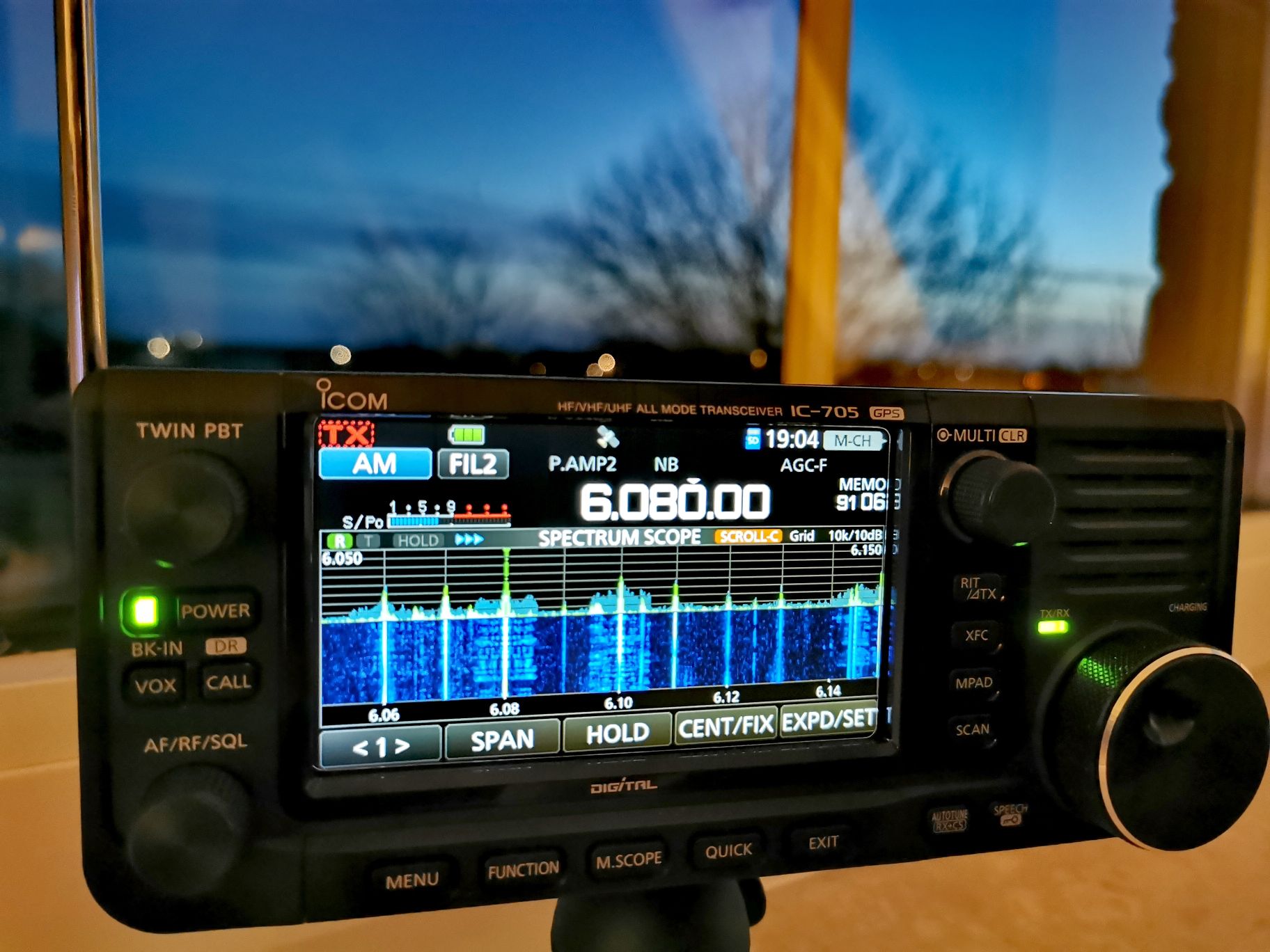
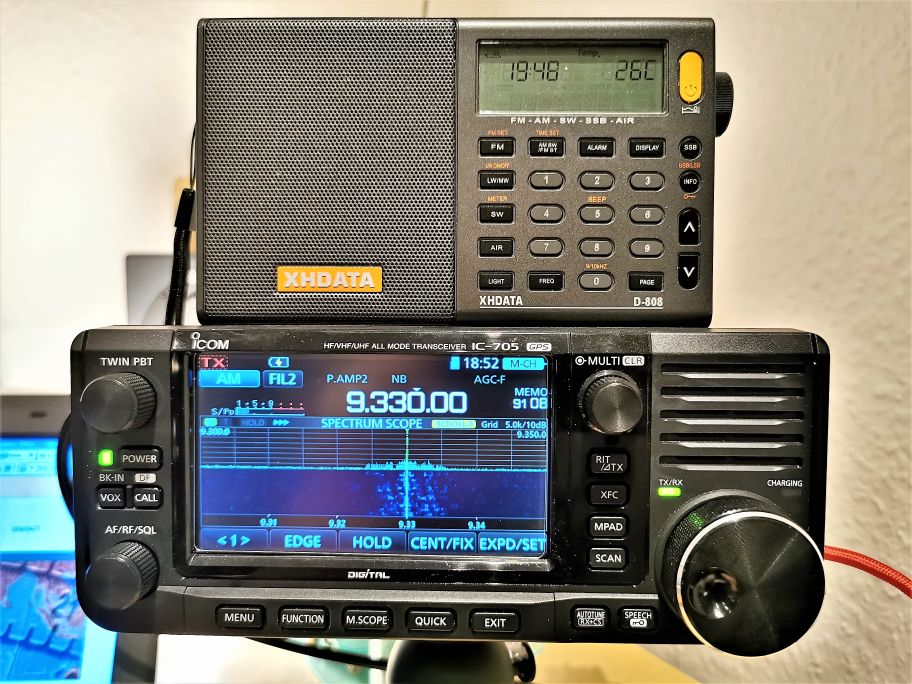
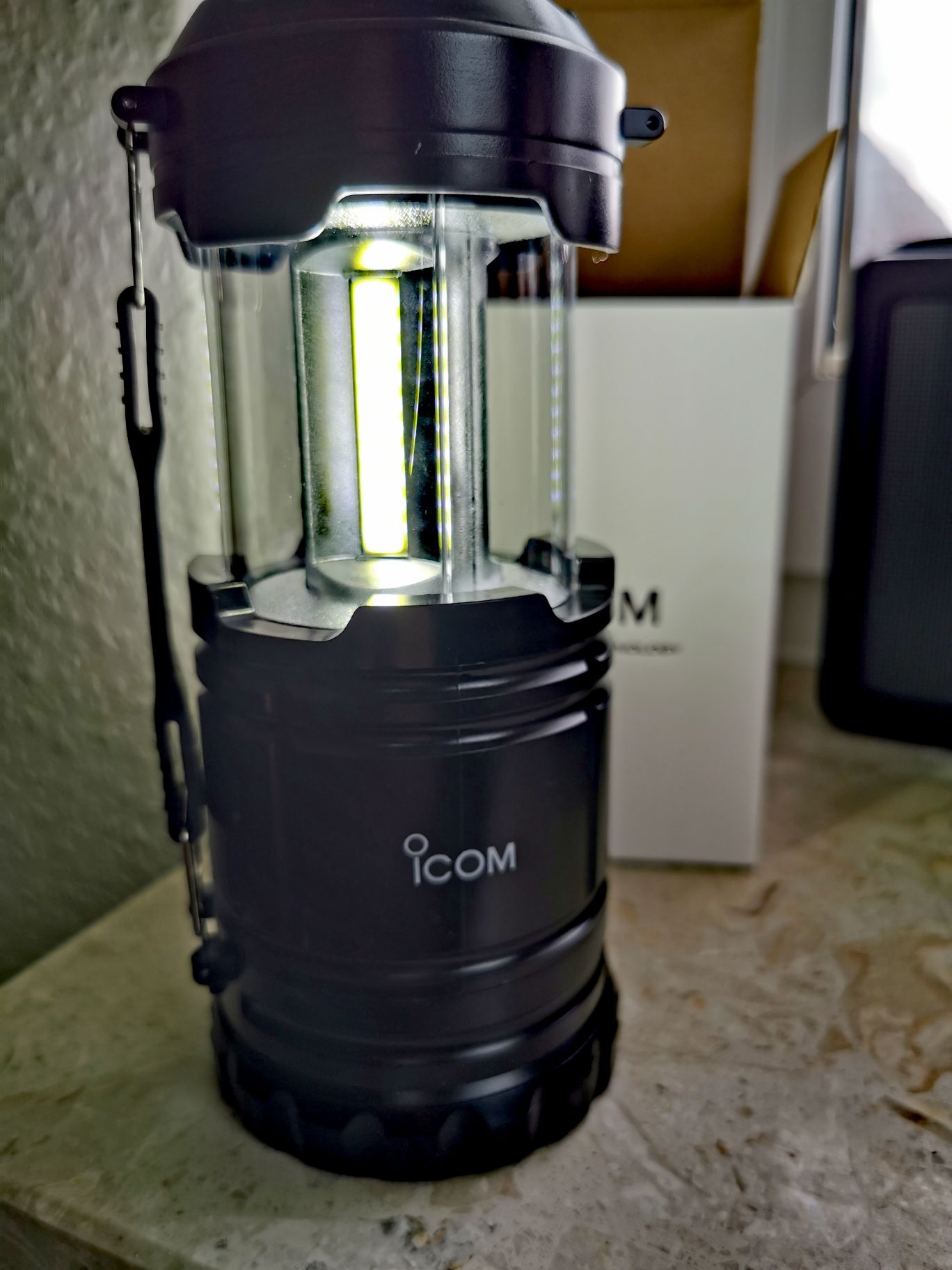
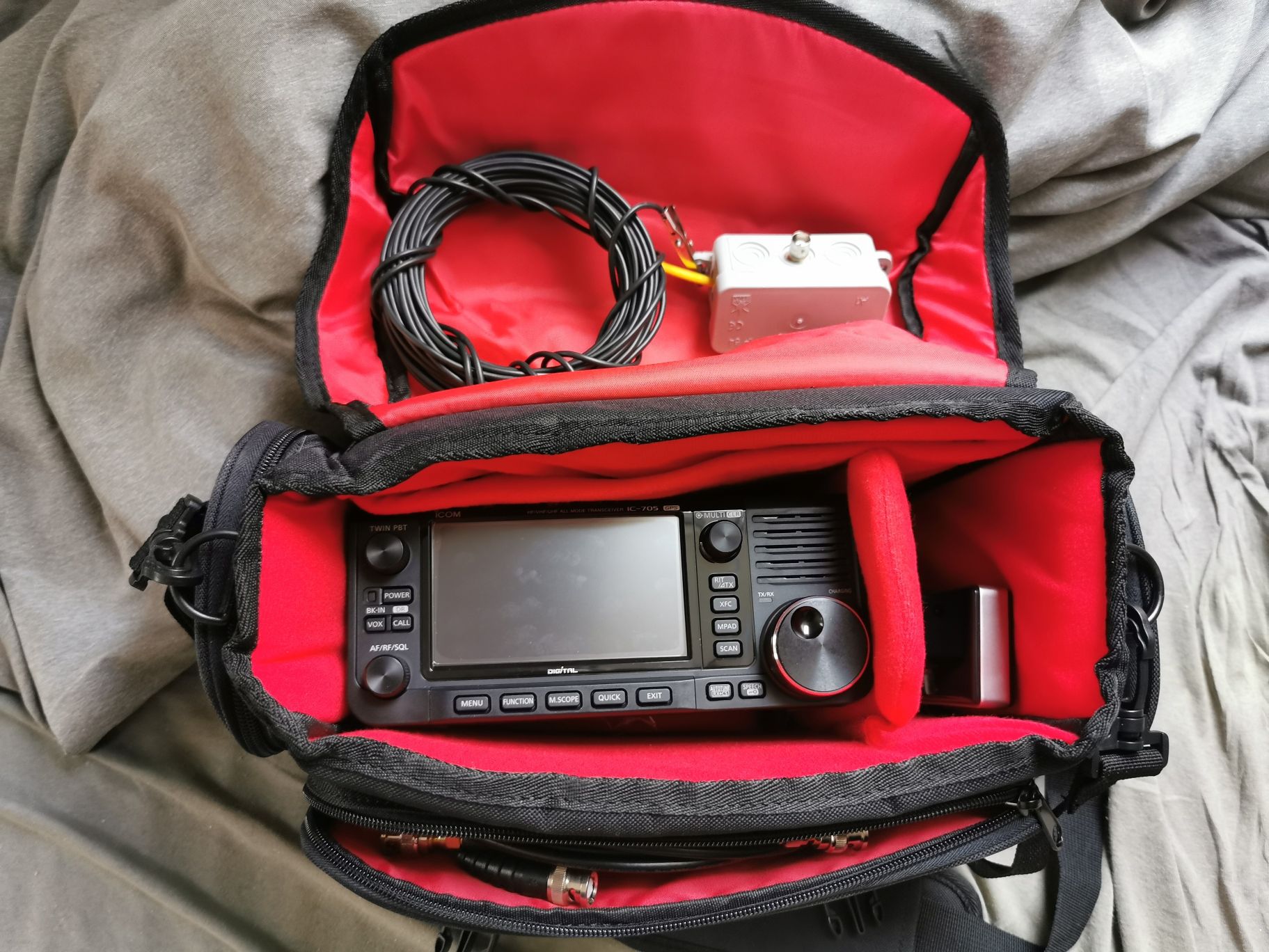
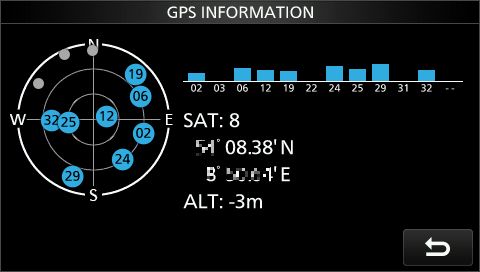
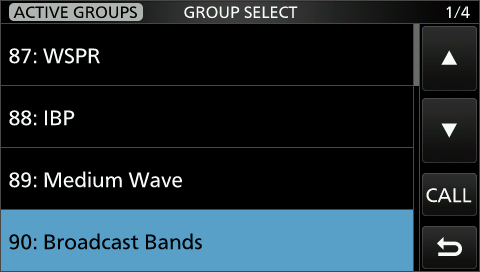
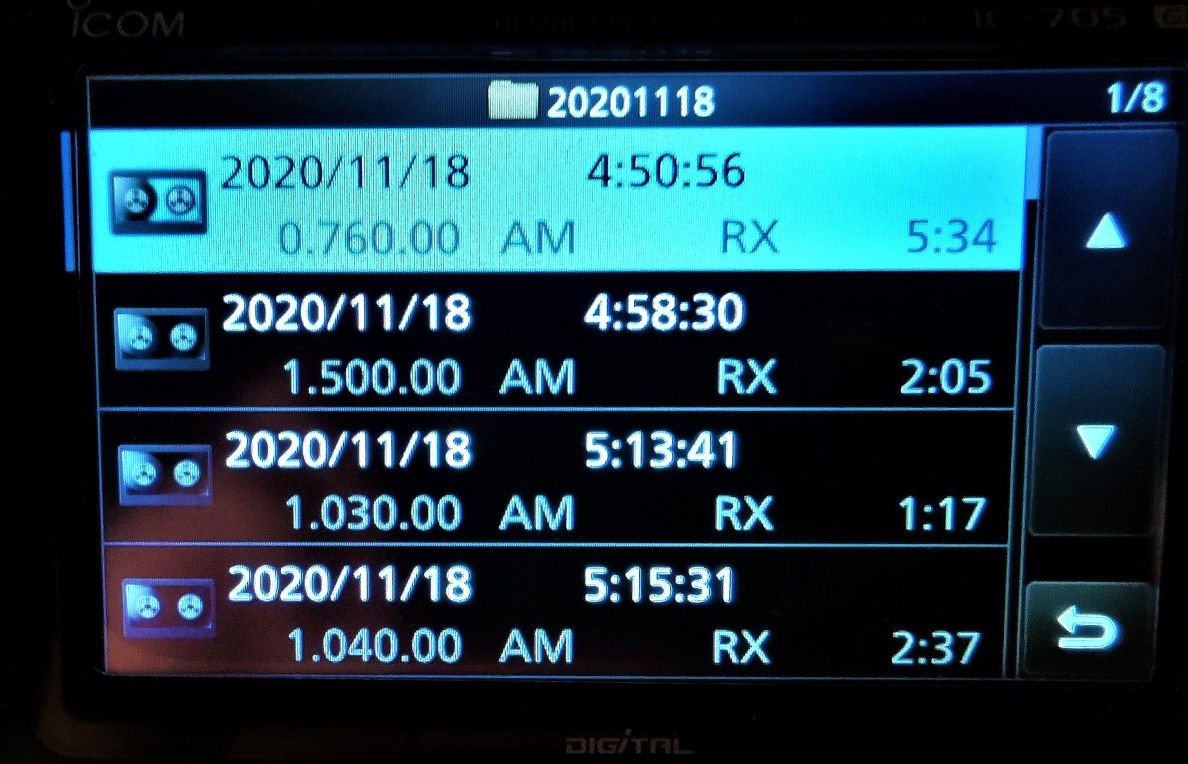
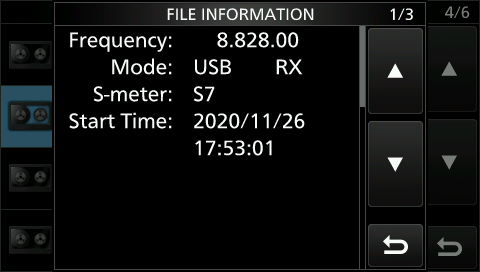
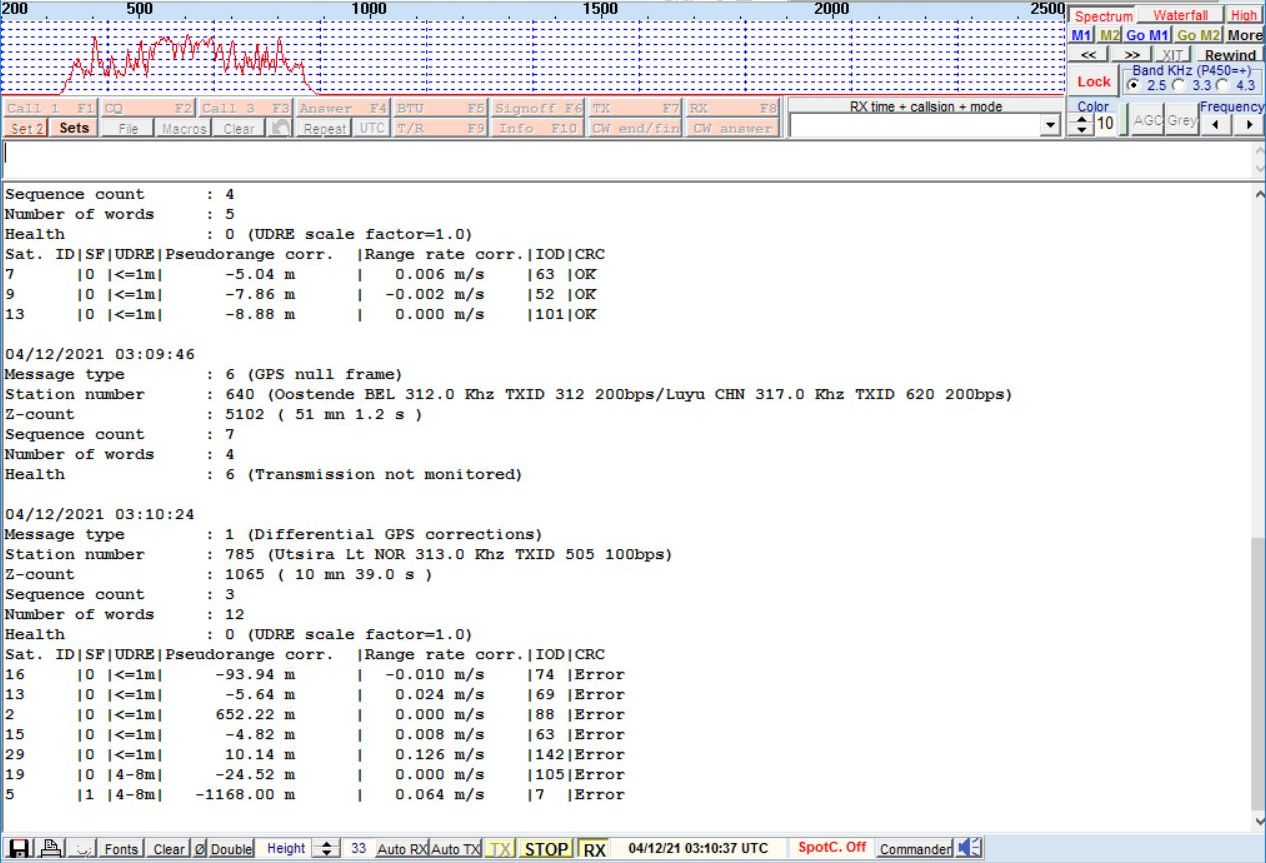
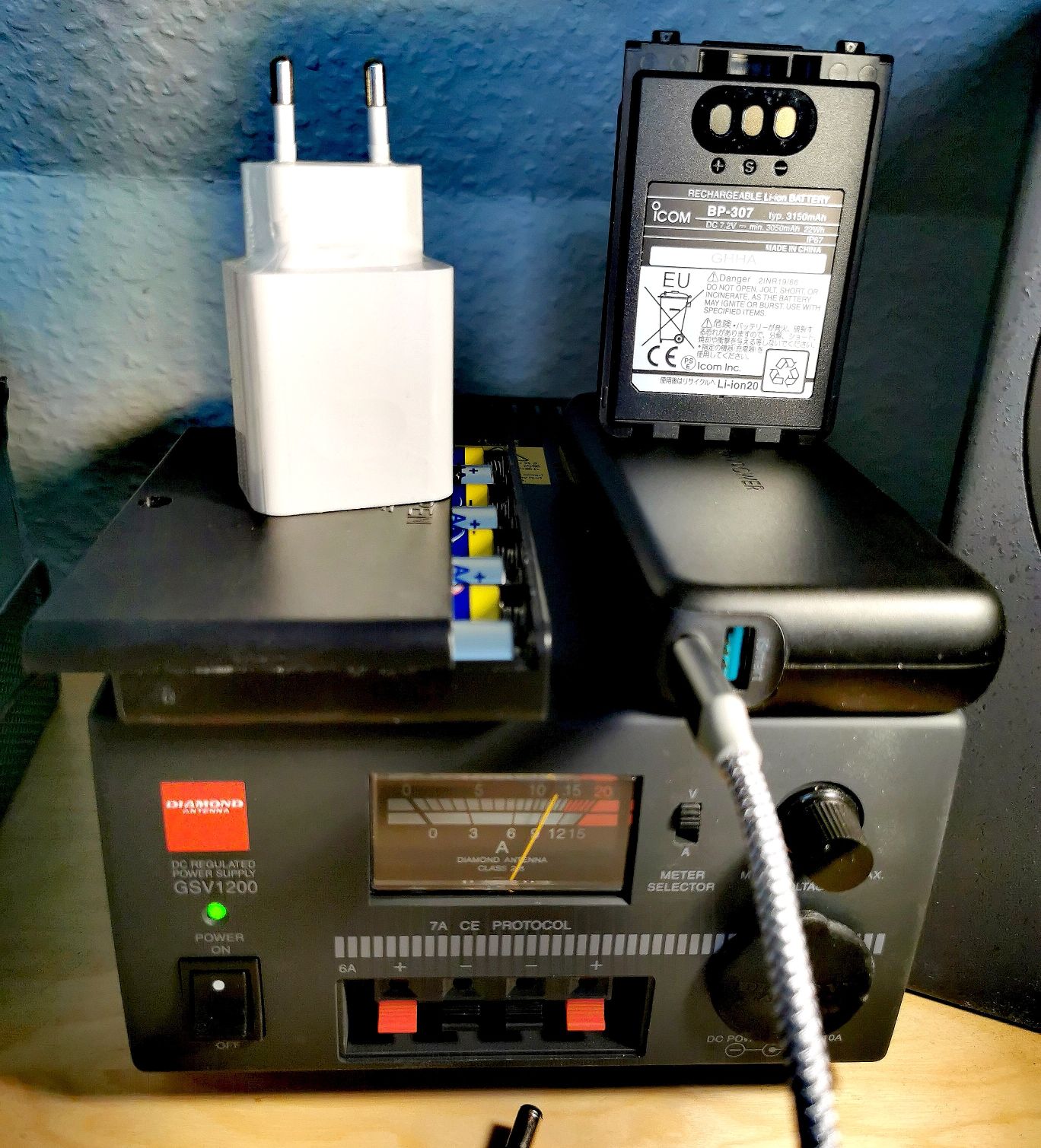
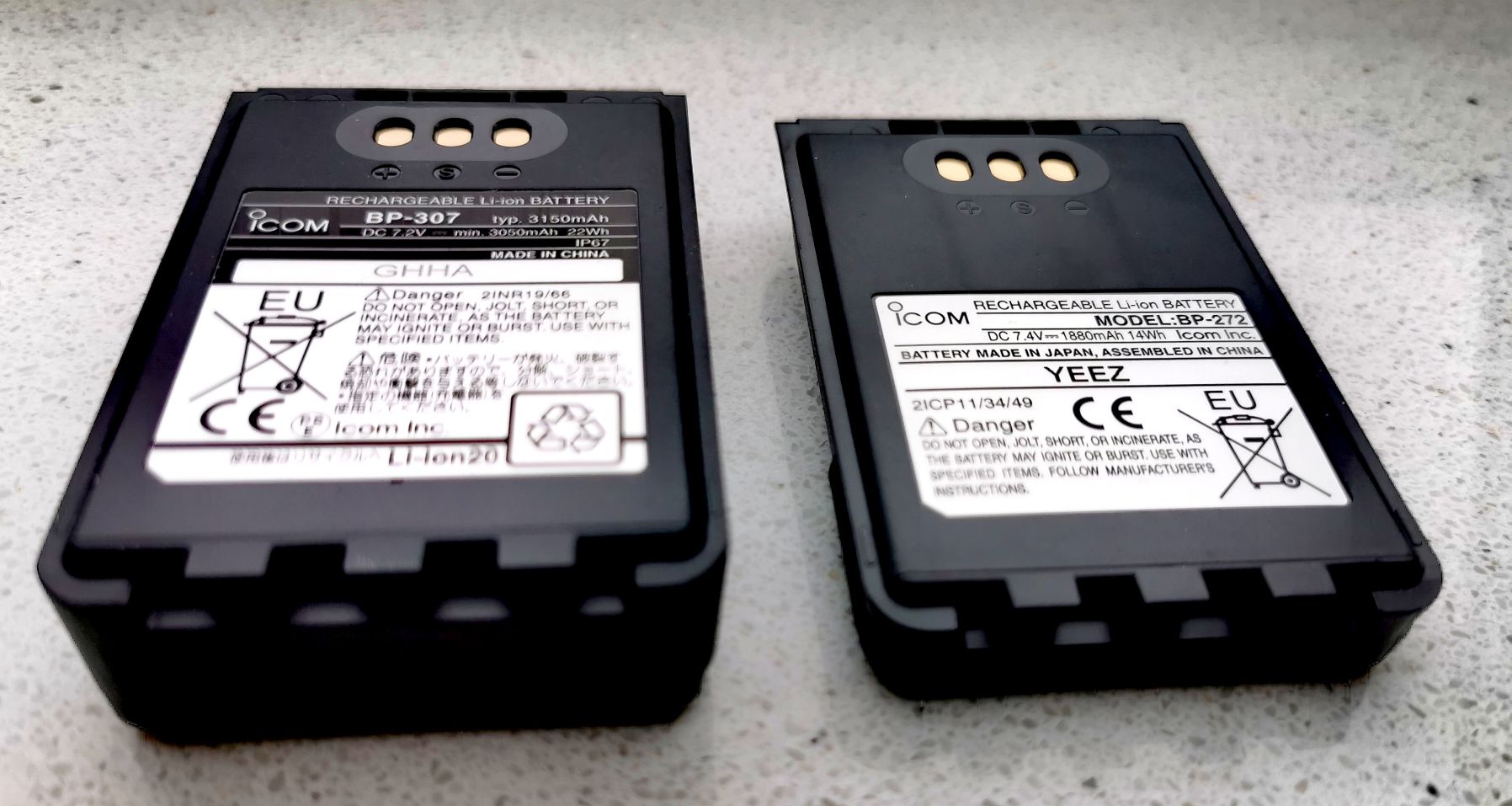
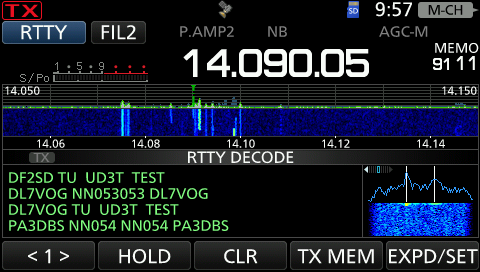
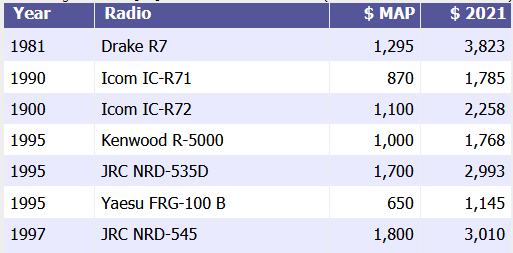
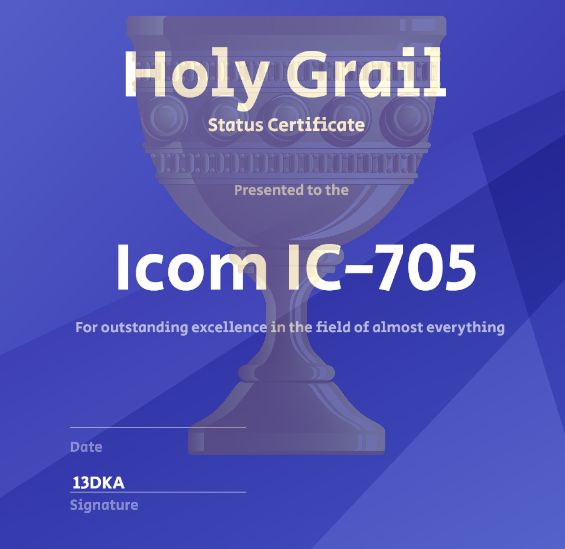
Thank you. Brilliant review. Will have to buy one now.
Thomas,
Thanks very much for your time and the articles you write. I started out SW listening as a child with my Rocket Ship Reciever clipped to the window screen. Later on I stumbled across QSO’s with K5 and W5 calls. That would be my first knowledge of Ham Radio. Today I do both, SW listening and Ham Radio. I love them both. Now I am 75-Years old, and more excited about both.
Your article on the IC-705 is increadable. Sounds like it will fill both of my needs.
Woody
Hi, Woody,
Yes, the IC-705 is truly an amazing radio. It’s a pleasure to use both for SWLing, FM, MW/AM, and all things ham radio. I’ve even done a little D-Star with it!
Thank you for the kind comment.
Cheers,
Thomas
Thanks soooo much! Put a Gold Star on your chart.
Great review, but I have a serious question: In your window-sill comparison, the S8800 sounded pretty darn comparable to the 705, except for some pulsing noise. So is the 705 $1000 better?
Seems like, listening with the whip in the evening at the bedside, the S8800 might be very nearly just as good with a great savings.
So I think if your only activity is doing live shortwave listening, it’s hard to justify the price of the IC-705. If, however, you’re a ham radio operator or DXer who wants a spectrum display, built-in recording and playback, and a nearly unlimited amount of filtering and adjustments, the ‘705 might be worth considering.
What’s surprising about the IC-705 is that it’s both a good transceiver and general shortwave coverage receiver.
Thank you! Re savings…what Thomas said… 🙂
The window sill video was just to demonstrate that the 705 works with a simple whip attached in the role of typical portable receivers (which is a rather unusual usage scenario for a ham transceiver),. and by coincidence it’s also showing how a noise blanker can be a great asset in a radio (the pulsing noise is the infamous PLC interference) Also, if you tune 2 radios to a not so weak station in a pretty QRM-laden room, they should sound similar.
The price difference shows in various ways as soon as you attach both to a big antenna, when you switch to SSB or CW, when you go to QRM-free places to hunt extremely faint and hard to catch DX, or (hopefully) in 10 years when the S-8800 has (likely) composted itself even more than it already did in the past 3 years, and the 705 has not. 🙂
BTW, this is not really a question of $1000 either – my Belka DSP review has a couple of clips showing how it beats the S-8800 in pretty much any metric on shortwave (particularly with both radios on their whips), and it costs less than half the price for an S-8800. In recent comparisons it actually made the 705 run for its money on a sizeable antenna, for 1/10th of the price.
Your S-8800 has “composted itself” somewhat in the past three years? Is that just a turn of phrase or have you had some actual loss of function with the S-8800?
I’ll admit that 705 is very tempting. I presume it has a lot of memories, and that those memories can store various settings (INCLUDING SIDEBAND, YES?). Does the 705 have the facility to scan, say, a bank of memories? I could envision storing a bunch of trans-atlantic air control frequencies, and then asking the 705 to step through them to see what’s active . . . just a thought.
And, yes, I will check out your Belka DSP review. Thanks for doing that!
Hi Jock,
My long-term niggles with the S-8800 can be found in the comment section here:
https://swling.com/blog/2018/08/a-detailed-review-of-the-tecsun-s-8800-and-comparison-with-the-tecsun-pl-660-xhdata-d-808/#comments
The 705 stores bandwidth and mode (among other things) in its 500 memories and I do have a “HF Aero” memory group too. But scanning SSB channels can be a bit tricky since it needs to be controlled by squelch. Now the “manual” squelch variant in the IC-705 seems to change timings/hysteresis according to the mode and I have successfully tried the squelch on clean SSB channels (and also CW!) but this is still a somewhat delicate matter – it will not work that well in summer for example, when distant thunderstorms make the lower bands pretty noisy and the scanner stops at every crackling on the band. But since the memories stored in a group can be selected very conveniently with the [MULTI] encoder I just turn that thing until I get a (usually NAT) channel with activity.
The 705 is tempting indeed, so tempting that I had to buy one! 🙂 But there is also a lot of potential for buyer’s remorse if it’s being bought for the wrong reasons or with wrong expectations – it was made to be taken to places where its enormous potential can be utilized and if you are lucky enough to have very little manmade noise at home it will be just as satisfying there (with a reasonable piece of antenna). It’s a radio for people who take “going great lengths/freezing their behind off for picking up extreme DX” for a sport.
If you buy it mostly for casual listening on the bedside on a whip you are certainly better off with a much cheaper, conventional portable radio of some kind, and each of those will be impressive when you take them outside to leave the noise zone too.
DARN YOU, “13dka”, (if that’s even your real name) FOR A THOROUGH AND WELL-WRITTEN REVIEW!!
It was bad enough when Thomas expounded the 705’s virtues at Winter Fest but you’ve gone over the top.
DARN YOU ALL THE WAY TO HECK!!!
Now I have to beg my wife to look the other way while I spend … $1300? Shipped? Dang.
Seeing the ham vs SWL thing further down (I am late to this party, apparently). In My World, which is perfect in every way of course, I have a simple litmus test: “Does it involve RF?” If the answer is “yes”, then I’m in.
Citizen’s Band Radio? RF – I’m in.
Amateur radio? Largely RF – I’m in. (I’m lookin’ at you, DMR …)
MWDX? RF – I’m in.
Scanners? RF – I’m in.
NDB hunting? RF – I’m in.
I could go on. I don’t understand the folks that limit themselves to only the parts of the hobby where they can transmit in the amateur bands. The spectrum is too wide to limit yourself to those 29 slivers.
it’s more that quite a few hams have a lamentable habit of coming into SWL spaces/places & extolling the virtues of hammy ham-hood, telling everyone how much better they could be and how much more they would know if only they got their ham licences. Apparently knowing Ohm’s Law, being able to calculate resonance in an RLC circuit, and memorising arcane details about band allocations long enough to pass a test turns some people into evangelicals.
I can only assume Thomas and the others who say they’ve never/rarely seen or experienced that attitude & behaviour are very very lucky people – because it’s a multiple-times-a-week occurrence in some places…
But yeah, RF is RF – at least until it gets into the microwave & beyond, when it becomes witchcraft 😉
In that sense (radio is radio), Mr W is inspirational. I enjoy his SOTA/POTA/WhateverOTA activations and it makes me want to 1) BUY A 705 LIKE I NEED A HOLE IN THE HEAD and 2) actually practice code. I passed the 13 word test in 1993 but … by a hair (helps that the test had been watered down considerably). Tom makes it look easy *and* fun.
But the 705 is also a great MW receiver which is my other “thing” – I like logging AM broadcast stations like I did when I was 12. I wouldn’t have to wonder which radio to pack for a trip – one really does do it all.
Peter L,
I’m with you; it it involves RF, turning a knob, and antenna-to-antenna, I’m in.
There was a writer of humorous articles for outdoor magazine — Pat McManus — who said “You have to get your wife accustomed to the idea of ‘all those fishing rods’ but no particular number of them, so that number remains vague and undefined.”
Likewise, there is the concept of “all those radios” . . . I think you catch my drift . . .
Well thank you… and sorry! 🙂
It’s so nice that I’m less to blame for this. 🙂 Ha ha!
Great review. But I ordered the 8 AA battery pack with your link and it has a 5.5×2.1 plug and my Icom 75 requires a 5.5×2.5 plug. Oh well it was only like $9 and it fits some other radios
Aw sorry, that’s bad. .( I bought mine years ago on Amazon.de and assumed they’re all the same when I looked up a similar box on Amazon.com. Maybe you can fit a matching 5.5×2.5 plug to one of them?
Even without soldering:
https://www.amazon.com/GOSONO-Female-connector-Security-5-5×2-5mm/dp/B07V4F9NDK/ref=sr_1_6?dchild=1&keywords=power+plug+5.5×2.5&qid=1623535108&sr=8-6
Thomas, could you kill the link please?
This is, hands down, one of the best information posts about the 705 I’ve read, and I’ve read pretty much all of them.. Pdf’s and all. I like how you provide realistic user interaction with the radio…
Thanks, I’ll be reading this for awhile…
R. Linder
Thank you very much for your kind words, much appreciated!
FOR the SWL I would really choose the Malachite from https://malahiteam.com/
They have a website now, I should have mine end of June, can’t wait, the one on the website is the update version not available as a clone.
I don’t think I’d buy a tecsun or Sangean again, too expensive for what you get and the Malachite offers so much more. The Tecsun PL-990 sounds really bad on SSB it’s really shocking how they could thing that using a flawed DSP chip still after all these years is acceptable.
Great review! Probably the single best ‘real world’ review available right now.
Thank you very much, Brian, I wouldn’t go that far tho! 🙂 Like I wrote, I found a couple of very thorough (but also very technical) reviews where people made actual measurements and left very valuable little tidbits about the design (which I could then use in my own article) and all of Thomas’ reviews are generally “hands-on”, “real world” reviews I trust, that’s why I have a 705 in first place! 🙂
Hmmmm! I wasn’t in the market for a new portable radio. That is BEFORE I read this article! But I could see it being an ideal tool for both my SWL and ham activities out in the great Aussie bush. Might be time to “liquidate” a few of my other radios to make way for this one. Thank you for such a comprehensive, detailed and informative review.
I took a look around on the web for that Icom lantern and found it at the Gigapart website. It says “This item is FREE when you purchase the Icom IC-705. This item is not for sale individually. We will remove this from any order that does not contain an Icom IC-705.” Other dealers like DXE also include the lantern with a purchase. https://www.gigaparts.com/icom-promotional-lantern.html
I bought a four-pack of these same lanterns on Amazon a few months ago. The price is great and quality of construction very nice too, with good light output.
https://www.amazon.com/gp/product/B00NPLSZF8
(sigh) I shouldn’t have read this review. I knew it was going to degenerate into the nagging ham evangelism that has been the bane of my shortwave listening hobby for decades. Shortwave listening is good because it might lead some of the benighted heathens into The One True Hobby. What I like to do is kind of ok because it just might lead me into what you like to do, and if it did, then I might be worth something. Decades of that stuff I’ve had to listen to. No thanks.
+1. And much more polite than I would’ve put it…
I don’t understand the dichotomy people create between shortwave radio listening and ham radio. I assume, at some point, a ham has been a jerk to an SWL and it’s had a lifelong impact. It’s sad, because those people don’t represent ham radio.
Saying ham radio is the “one true” hobby and SWLing is only a stepping stone makes no sense to me. They’re two completely different activities.
When I started the SWLing Post, I was already a ham radio operator, but the site focuses on listening rather than transmitting. It’s true that ham radio gets mixed in, but so does scanning, astronomy, travel, history and a number of other topics. The site celebrates radio in all forms with a focus on listening.
If you look at 13DKA’s article, the whole reason it’s been posted is because he’s showing how this tabletop SDR makes for an amazing listening device. That’s because, like me, he’s a die hard SWL and BCL. To this day (like 13DKA) I do way more listening than transmitting. And I must agree with him: the IC-705 is pricey, but man-oh-man is it a great receiver!
If someone wants to become a ham? Brilliant! If they don’t? Brilliant!
If one doesn’t like the topic of content that’s been posted, just move on. No worries!
Don’t do things to please others. Do what floats your boat, then share your enthusiasm with others! 🙂 Simple!
-Thomas
Thomas,
There was a time I considered getting my ticket. I was getting bored with the lack of SW stations broadcasting and several big English speaking ones leaving the air or not broadcasting to North America anymore.
I never had any problems with any HAM operator in fact I had sent out reception reports to many stating I had picked them up on my receiver and I was trying to get a HAM station verified from each state in the US just as a side hobby to my SW DXing. I received many great QSL cards and personal letters that were really nice.
I studied for my test and even bought a Kenwood 2 Meter transceiver to listen to local/repeater traffic. I came to realize based on my own personality and quirks I have that I wouldn’t enjoy just talking to others even all over the world . I still on occasion just listen, laugh, cry, and gain radio knowledge from HAM radio, but, my heart belongs to SW listening and at times sending out reception reports. SWL and DXing continues to be my primary radio hobby.
Besides Thomas, I thought the title of this blog was SWLing Post ( SHORTWAVE LISTENING POST?) Maybe it needs to be changed into HAM/SWLing Post as it seems more and more articles and comments are from HAMS? It wouldn’t bother me, but please readers, don’t disparage or look down on those of us in the Radio Hobby who want to be a HAM operator. It’s not that we can’t get our ticket, it’s we don’t want to!
Please edit want to, to don’t want to get ourvHAM ticket on my reply to Thomas.
I actually have moved much of my ham radio posts over to QRPer.com–my other blog. I still post some news items that are ham radio related here because at the end of the day, I really feel this blog celebrates all things radio and I like that.
I can promise you that I have never looked down on someone for not being licensed. None of my close friends ever have–and none of the ham radio operators who produce guest posts here ever will–treat SWLs, BCLs, or any others disrespectfully. I find the though a bit absurd, actually. It’s like being a single malt Scoth enthusiast and looking down on those who like bourbon or vodka. Life’s too short for pettiness like that. Indeed, some of the most knowledgable radio people I know aren’t hams. They could be, of course–I mean the test is accessible–it just doesn’t interest them and that’s perfectly fine. I wouldn’t want them any other way.
As I’ve gotten older, I no longer allow others to make decisions for me. I do what interests me and, frankly, I don’t care what others think. What matters is what fuels my passion and how I treat others, which will always be with dignity and respect.
There are bad players in every aspect of the radio world, and there are inspirational people.
Here, we celebrate those inspirational people and conveniently ignore those trolling, self-serving, drama queens. They can go elsewhere. I really don’t mind. 🙂
Thomas this is exactly what I love about this website. You sir are a diplomat for radio enthusiasts of all stripes. I’ve been a dedicated reader at least eight or nine years and your kindness and compassion come through your articles.
I came close to becoming a ham once about 20 years ago. I decided not to though because I know me and know I’d never actually transmit. I suppose I don’t go out of my way to talk with people. ha ha Some digital modes now have me intrigued but probably not enough to become a ham. I can decode them now without a license.
But I find ham radio stuff fascinating. I’m not threatened by it. It doesn’t offend me. In fact I’m not afraid of learning something new, I love it.
Please don’t take these comments to heart from those who are offended by the mere mention of ham radio. You are probably right in that someone sometime spoiled the fun for them. I feel sorry for them. They don’t speak for me though. Keep on doing what you do. Your site is a radio beacon.
When you see the Coffee Fund contribution chunk from “Abe” that’s actually me by the way. Long overdue
Thank you
Thomas, I know I am unreasonable about this subject. Thanks for staying civil to me. I’m trying to stop blowing up about it. In my youth, about the end of the last ice age, I got the line that “Shortwave listening is good because it might lead you into The Hobby..” I swear, I got that line exactly like that from at least six different people. I started to think that they must tattoo it on your frontal lobes when you get a license. I’m still reacting and overreacting to that, so many years later.
I got into SWL because I wanted to learn about foreign countries and cultures. I wanted to know what **they** thought was important, not the occasional CBS-NBC-ABC story about a military parade or a train crash in their quarter of the globe. Unfortunately SWL is not so good at that now with national broadcast services drying up. Fortunately there are other ways to get foreign information. Unfortunately again those are subject to firewalls, bottlenecks, and censorship in a way radio wasn’t. Oh well, the world changes for better, for worse, and usually for both at once.
I never got a ham license because I didn’t think I had anything to say (and certainly nothing to say about antennas and weather, which seems to cover most of the ham conversations upon which I have eavesdropped). I think I should take my own advice and “never miss a chance to shut up.” Unfortunately, I am cranky and blow off unreasonably from time to time. Sorry.
No apology necessary, friend.
I owe my my love of travel, my language skills and heck(!) my post-graduate degree (anthropology)–to shortwave radio! As a kid, it opened up the world to me and still does today. I get a massive thrill out of doing a little “content DXing” on the shortwaves. It’ll be a part of who I am the rest of my days!
I also firmly believe that SWLing helps one hone their critical thinking skills. Even from a young age, I learned that everyone has a voice and an opinion. Listening to stations as diverse as Radio Moscow, Radio Peking, RNW, and the BBC helped me sort out opinion and fact, subjectivity and objectivity. The SWLs I know have had much the same experience.
Heh, Thomas beat me to it. Thank you! 🙂
Did I really write that? Or did I just write “once you pave the ground” as a device to mention a few highlights of the awesome transmitter anyway (after announcing that I’d be ignoring it) while deliberately keeping it neutral because I actually feel much the same about hams thinking SWL stands for “still without license”? Besides “get a license”, “paving the ground” could as well mean “get a tuner or a resonant antenna”, “ask your wife” or “do the MARS mod”?
And yes, some may want to decide for a license instead of the MARS mod or do nothing, particularly not asking the wife – either way is OK and completely at everyone’s own discretion, my point is that the 705 gives you that choice, not more, not less. 😉
If you have one…you know what it’s capable of coupled with a great antenna…if you dont you are sure to look for every excuse no to pony up and buy one…
For its size and ability it has no peer
Awh… One big miss here. Just too bad that they couldn’t extend the range of the upper VHF RX from 200MHz limit, up to 225MHz, for for all-mode 222MHz in the 1 1/4M band. Yes, you can get a transverter for that, but still, it just misses that mark. Other than that, the IC-705 is very enticing.
That’s a part of the missing 10% I mentioned. It’s easier to live with outside of region 2 tho, for example 174-230 MHz is used for DAB in the EU and listening to Brazilian pirates enjoying themselves on old FLTSAT transponders is very quickly getting boring.too 🙂
Wonderful article…very informative.
Hi Jay, thank you! Means a lot hearing that from a “radio enabler celebrity” 🙂
Ollie
US $1300 for a mobile radio with no battery charger or AC power supply? Price includes a transmitter and VHF/UHF ham bands that I will never use. I’m sticking with the Sangean ATS-909X2 which has better speaker audio for shortwave broadcast listening than the Icom. If I want another shortwave receiver I won’t buy a two-way radio.
Really nice looking and all but with very few SW Stations of note broadcasting anymore, why spend that much money? Back 10 years ago yeah, I would have jumped but now, meh! I doubt if this receiver can pick up any better or more stations then one of my better portables like a 909x or SDR IQ both old but I still use on occasion. I just can’t see paying money on a new SW receiver anymore.
I think one of the benefits of the IC-705 is that it’s a transceiver. For 13DKA and for me, it’s actually a tool for snagging contacts all over the world in both transmit and receive. If you’re a ham that’s also an SWL/BCL? The IC-705 has a lot of appeal.
If you’re just looking for a shortwave portable, then it’s more cost effective to go the Tecsun/Sangean/C.Crane route!
Agreed. I had been kicking around the idea of purchasing an ICOM R8600 to replace/complement some of my older desktops but with the deterioration of the number and quality of shortwave broadcasters (as opposed to the SWL wonder years of the 80’s) I just can’t justify the 8600 acquisition – its not so much the cost as the waning amount of legitimate English shortwave broadcasters.
This is a truly outstanding piece, 13DKA!
Thank you so much for taking the time to take us on an IC-705 deep dive. Simply amazing. Thank you!
Thomas
Thank you, and thank YOU for taking the time to bring the world of radio to us every day! 🙂
Ollie
The pleasure is all mine! 🙂
It’s a cool radio but does it sound as bad as the IC-7300 ? I find my FT-891 sounds so much better + the 7300 cuts off a lot of the lower frequencies which doesn’t make it a great radio to listen to SWL.
I really love the look of this radio, I might get one soon, http://qrp.visair.ru/#
One cool thing about the 705 is that it can do D-Star simply by connecting to the Wifi, no hot spot required, I think this is cool,
Hi Mark,
I commented on this in earlier articles, the IC-705 does not seem to have the 200Hz roll-off in AM like the IC-7300 apparently has, and I ‘m having a blast connecting it to a big speaker to get the full, rich bass on music programs.
That being said, I’m not so sure anymore what the deal with that roll-off on the 7300 is: I remember that being stated in the specifications, but that seems to be gone in later versions, so maybe that got fixed with a firmware upgrade?
Hi Ollie, I guess I’m just sceptical of another SDR from Icom, I was really disappointed with the audio quality from my 7300. I just use the FT-891 a lot more now because of the Audio alone.
Another cool thing though with the 705 is the built in sound card and GPS so less stuff needed to work digital out portable.
It’s a shame it can’t output the 10 watts on battery, Lithium batteries are so good these days that there is really no valid excuse they could make.
There’s a “bass” setting on the 7300 that should really be cranked up for SWL, as well as the rounded filter envelope. I can’t compare it with the 891, but with those settings, it sounded better than my 450d.